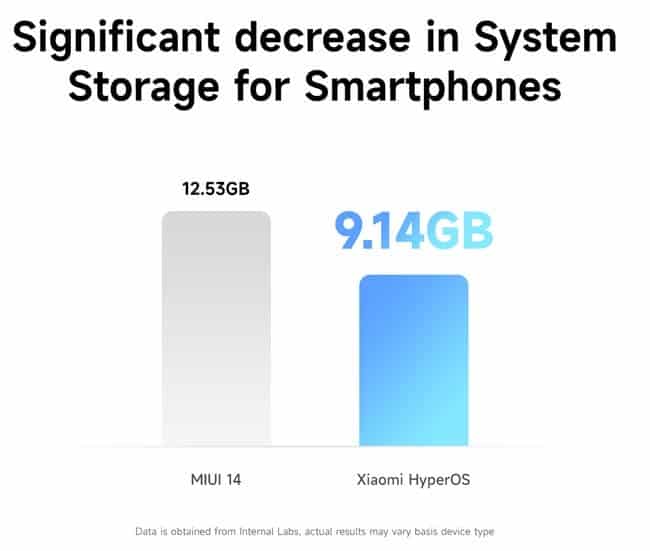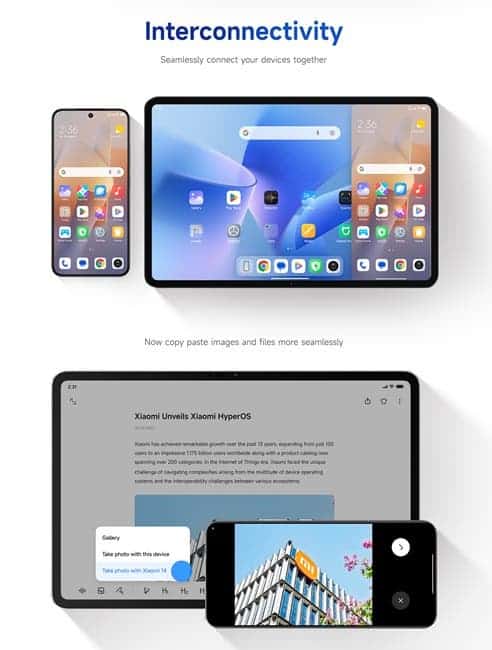Xiaomi’s new operating system, HyperOS, aims to provide a unified platform for connecting various personal devices, cars and smart home products. This signals Xiaomi’s strategic move towards creating cohesive ecosystem where users can seamlessly integrate and control their interconnected devices. The introduction of HyperOS is in line with the broader industry trend of developing complete ecosystems that enhance the user experience across multiple devices.
HyperOS is built on five foundational pillars emphasizing system-level optimization, interconnectivity, active intelligence, privacy and security, and an open platform. These pillars collectively aim to improve performance and user experience across domains by ensuring seamless integration, intelligent operation, privacy protection, and an open environment for further customization and development. The emphasis on these aspects reflects Xiaomi’s commitment to providing a holistic and user-centric operating system.
HyperOS performance details
HyperOS demonstrates remarkable performance improvements by using the open source Xiaomi Vela. With a 14% reduction in response latency, a 17% improvement in message delivery latency, and a 16% improvement in task switching, the operating system prioritizes peak performance while effectively managing power consumption. This optimization is facilitated by the implementation of Apache 2.0. These performance improvements are intended to provide users with a more responsive and efficient multi-tasking experience.
In addition, HyperOS includes precise load estimation capabilities. It comprehensively analyzes thread connections to provide accurate CPU load estimates. This feature ensures that system resources are used efficiently, contributing to a more balanced and responsive user experience.
It improves the user experience by delivering faster performance, achieving up to a 14% reduction in average latency on mission critical tasks. It also significantly reduces the maximum scheduling delay for such tasks by 72%. This optimization provides smoother operation and responsiveness, especially for core functions.
In addition, lightweight devices benefit from a 14% reduction in interrupt response delay, a 17% reduction in message delivery delay, and a 16% reduction in task switching delay, according to Xiaomi Internal Labs. These improvements contribute to more responsive and efficient operation on devices with limited resources.
HyperOS brings a significant reduction in system storage requirements for smartphones compared to MIUI 14, offering a streamlined 9.14GB as opposed to the previous 12.35GB. This optimization allows users to have more available storage for their apps, files and other content on their devices.
HyperOS reduces system storage consumption 
What’s more, HyperOS delivers smooth I/O (Input/Output) performance with near-zero latency, ensuring consistent performance over a 50-month period. The system also improves over-the-air (OTA) updates, reducing OTA busyness by an impressive 79% and shortening OTA update times by 24%. This contributes to a more efficient and user-friendly update experience for Xiaomi device users.
HyperOS prioritizes customization with its living design philosophy. It introduces a new lock screen design with multiple customization options.
Gizchina News of the week
In addition, the Control Center has undergone a renovation to improve accessibility. This is complemented by a new media player widget, redesigned system icons and diverse user interface (UI) experiences, providing a refreshed and user-friendly interface for Xiaomi device users.
The system font, MiSans, is designed to be comprehensive, supporting over 600 languages, 20 writing systems, and featuring a massive collection of more than 100,000 glyphs. This ensures comprehensive language support for users worldwide.
The improved floating window feature allows users to view multiple apps simultaneously, offering a multitasking experience. Additionally, a new workstation mode has been introduced to improve performance specifically on tablets. Along with these updates, the Weather app has undergone a redesign for a more modern and user-friendly interface.
HyperOS connectivity features 
HyperOS enhances device connectivity through a range of features:
1. Home screen+: Facilitates easy drag and drop functionality between phones and tablets.
2. Shared Clipboard: It allows a convenient function to copy and paste to different devices.
3. Notes app: It allows users to capture photos on their mobile devices and seamlessly insert them into notes on Xiaomi tablets.
Other HyperOS features 
HyperOS offers several innovative features including:
Xiaomi Smart Hub: Integrates independent devices, offering real-time status updates and active control. This feature ensures a seamless and interconnected experience across a range of smart devices.
Xiaomi HyperMind: This feature proactively understands user requirements and encourages collaboration between surrounding devices by analyzing and adapting to user habits. It aims to create a smart and responsive ecosystem tailored to user preferences.
End-to-end security: HyperOS prioritizes user security by implementing mutual security checks and hardware-level encryption. This approach ensures reliability and protects user privacy throughout the system.
An intelligent ecosystem: HyperOS aims to create an intelligent mobile space centered around users by seamlessly connecting everyday devices. This integrated approach improves the overall user experience.
A consumer IoT platform: Leveraging the world’s largest consumer IoT platform, HyperOS connects all devices, promoting human-centric innovation. This interconnected ecosystem ensures that different devices work seamlessly together to meet user needs.
Availability of HyperOS in India and supported devices
The following devices have received or are scheduled to receive the HyperOS update:
1. Xiaomi 13 Pro
2. Pad 6
3. Redmi Note 13 series
4. Redmi Note 12 series
This list represents the initial devices that have already received the HyperOS update or are scheduled to receive it in the coming months.
List of devices that have already received HyperOS in India
Xiaomi 13 Pro
Xiaomi Pad 6
Redmi 12 5G
Xiaomi Redmi 12C
Redmi 11 Prime
Redmi Pad
List of Xiaomi Devices to Get HyperOS in March 2024 (India)
Xiaomi 12 Pro
Redmi Note 13 Pro +
Redmi Note 13 Pro
Note 13
Redmi Note 12 Pro +
Xiaomi Redmi Note 12 Pro
Redmi Note 12
List of Xiaomi Devices to Get HyperOS in Q2 2024 (India)
Xiaomi 11 Ultra
Xiaomi 11T Pro
Mi 11X
Xiaomi 11i HyperCharge
Xiaomi 11 Lite and 11i
Mi 10
Xiaomi Pad 5
Redmi 13C series
Redmi 12
Note 11 series
Redmi 11 Prime 5G
Xiaomi Launches HyperOS in India: Checkout the List of Supported Devices







